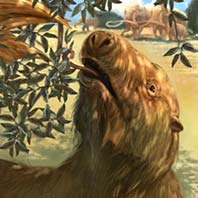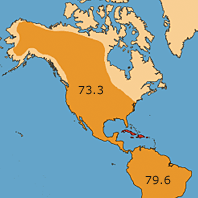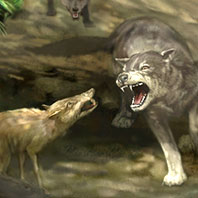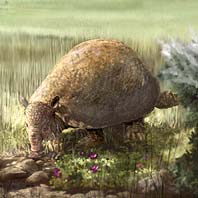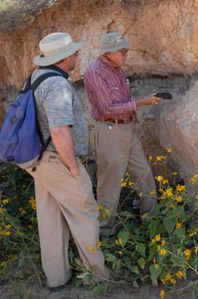End of the Big Beasts
by Peter Tyson
Who or what killed off North America's mammoths
and other megafauna 13,000 years ago?
It takes a certain kind of person to tackle this question in
earnest. You have to be itching to know the answer yet patient
as a Buddha, for the answer is frustratingly elusive. I know
I'm not the type. I'm intrigued by the question but far too
anxious to calmly accept, as some experts suggest, that it
might be years or decades, if ever, that a definitive,
widely accepted solution will come. (To follow the
long-running wrangle over this question, see
The Extinction Debate.)
The four people I spoke to about the megafaunal or
"large-animal" extinctions possess this sort of edgy
sangfroid. While keeping an open mind, they also stand in four
decidedly different camps regarding why America's rich
complement of big beasts went extinct quite suddenly at the
end of the Ice Age. The four camps are known tongue-in-cheek
as "overkill," "overchill," "overill," and "overgrill"*:
-
Archeologist Gary Haynes, University of Nevada Reno, and
others think that the continent's first human hunters,
fresh from Siberia, killed the megafauna off as they
colonized the newly discovered land.
-
Donald Grayson, an archeologist at the University of
Washington, Seattle, along with colleague David Meltzer of
Southern Methodist University, believes that climate
changes at the end of the Pleistocene epoch triggered the
collapse.
-
Mammalogist Ross MacPhee of the American Museum of Natural
History has advanced the idea, with virologist Preston
Marx, that a virulent "hyperdisease" brought by the first
Americans might have raced through species with no natural
immunity, bringing about their demise.
-
And, in the newest hypothesis advanced, geologist James
Kennett, U.C. Santa Barbara, and colleagues propose that a
comet impact or airburst over North America did it.
So why is the answer so elusive? As often happens in the
paleosciences, it largely comes down to lack of empirical
evidence, something all four hypotheses arguably suffer from.
(There's a fifth hypothesis, actually—that a combination
of overkill and overchill did it.)
Overkill
In the early 1960s, ecologist Paul Martin of the University of
Arizona postulated that the first Americans, after crossing
into the Americas over the Bering Land Bridge, hunted the
megafauna to extinction. For many years, "overkill" became the
leading contender. The timing seemed more than coincidental:
Humans were thought to have arrived no earlier than about
14,000 years ago, and by roughly 13,000 years ago, most of the
megafaunal species abruptly vanish from the fossil record.
(See a list of
all 35 extinct genera of North American Ice Age mammals.)
But skeptics have asked, Where's the evidence? Grayson
and Meltzer (overchill) have noted that late-Ice Age sites
bearing megafaunal remains that show unequivocal sign of
slaughter by humans number just 14. Moreover, they stress,
only two types of giants were killed at those 14 sites,
mammoth and mastodon. There's no sign that early hunters
preyed on giant ground sloths, short-faced bears, or the
massive, armadillo-like glyptodonts, for instance. (Forensic
studies of a cache of Clovis tools found in 2008 suggest the
Clovis people did hunt now-extinct camels and horses.) That's
hardly enough evidence, Grayson and Meltzer argue, to lay
blame for a continent's worth of lost megafauna at the foot of
the first Americans.
Gary Haynes (overkill) begs to differ. "I don't care what
anybody else says, 14 kill sites of mammoth and mastodon in a
very short time period is extraordinary," he told me. It's one
thing to find a campsite with some animal bones in it, he
says, quite another to find the actual spot where an ancient
hunter felled and butchered an animal—where, say, a
spearpoint turns up still sticking in bone. "It's very, very
rare to find a kill site anywhere in the world," he says. And
absence of other megafauna in kill sites doesn't mean they
weren't hunted. "There is no doubt Native Americans were
eating deer and bear and elk," Haynes says, citing several
large mammals that pulled through. "But you cannot find a
single kill site of them across 10,000 years."
The dearth of widely convincing evidence only serves as a
spur.
Could what scholars agree must have been a relatively modest
initial population of hunters have emptied an entire continent
of its megafauna virtually overnight, geologically speaking?
(In fact, it's three continents: South America and, to a
lesser extent, Northern Eurasia also lost many large species
at the end of the Ice Age.) For his part, Ross MacPhee
(overill) finds it hard to swallow. "I just don't think it's
plausible, especially if we're also talking about collapses
for megafauna that didn't actually go extinct." Certain
populations of surviving big beasts, including bison in North
America and musk oxen in Asia, are known to have fallen
precipitously at the end of the Ice Age. "It gets a little bit
beyond probability in my view that people could have been so
active as to hunt every animal of any body size, in every
context, in every possible environment, over three
continents."
Overchill
Could climate change have done it? Scholars generally agree
that North America witnessed some rapid climate adjustments as
it shook off the Ice Age beginning about 17,000 years ago. The
most significant swing was a cold snap between about 12,900
and 11,500 years ago. Known as the Younger Dryas, this partial
return to ice-age conditions may have stressed the megafauna
and their habitats sufficiently to cause widespread die-offs,
Grayson and others believe.
Detractors, again, point to the lack of evidence. "There
aren't any deposits of starved or frozen or somehow naturally
killed animals that are clearly non-cultural in origin that
you would expect if there was an unusual climate swing," says
Haynes. "I don't think that evidence exists." Another question
dissenters have is how the megafauna survived many abrupt
glacial and deglacial shifts during the past two million years
only to succumb to the one that closed the Pleistocene. "It
just doesn't hold water," Jim Kennett (overgrill) told me.
Grayson admits that overchill advocates have failed to develop
the kind of records needed to test climate hypotheses in
detail. But he focuses on climate change, he says, because he
sees absolutely no sign that people were involved. "You can't
look at climate and say climate didn't do it for the simple
reason that we don't really know what to look for," Grayson
told me. "But what you can do fairly easily is look at the
evidence that exists for the overkill position. That position
would seem to make fairly straightforward predictions about
what the past should have been like, and when you look to see
if it was that way, you don't find it."
Overill
A lack of data has particularly plagued the "overill"
hypothesis. This is the notion that diseases brought
unwittingly by newly arriving people, either in their own
bodies or in those of their dogs or perhaps rats, could have
killed off native species that had no natural immunity.
MacPhee devised this hypothesis with Preston Marx after
realizing that the link between initial human arrival and
subsequent large-animal extinctions was strong not just in
North America but in many other parts of the world (see map in
sidebar), but that in his opinion, convincing evidence for
hunting as the culprit simply did not exist.
Despite what he calls "prodigious effort" using DNA techniques
and immunological probes, however, MacPhee and his colleagues
have failed to detect clues to any pathogens in megafaunal
bones, much less nail down a specific disease, like rabies or
rinderpest, that could have jumped from one type of animal to
another and wiped out all the big beasts. "There's no
evidence, and there's virtually no possibility of getting any
evidence," Kennett told me.
"[Overill] doesn't even have circumstantial evidence, because
we can't prove there was hyperdisease," Haynes says. "We can
prove people were here, and we can prove climates were
changing." Fair enough, says MacPhee, though he points out
that the burgeoning ability of Asian bird flu to infect across
species boundaries seems to suggest that some diseases are
ecologically and genetically preordained to, as he puts it,
"go hyper."
Overgrill
The most recent hypothesis, advanced by Kennett and 25 other
scientists in a 2007
Proceedings of the National Academy of Sciences paper,
concerns the proposed cosmic impact. Right about the time the
Younger Dryas began and at least 15 of those 35 extinct
mammals and arguably the Clovis culture itself appear to
vanish abruptly from the fossil record—that is, right
about 12,900 years ago—Kennett et al see markers
of a major catastrophe. The markers lie in a thin layer at the
base of a "black mat" of soil that archeologists have
identified at over 50 Clovis sites across North America.
According to Kennett, fieldworkers have uncovered fossils of
the 15 genera of mammals that survived right up to Younger
Dryas times just beneath—but neither within nor
above—this black mat. (Some fossil bones butt up against
this layer so closely that the mat has blackened them, Kennett
told me.) Stone-tool remains of the Clovis culture also end
just beneath the mat, he says. Moreover, Kennett and the team
he works with have identified charcoal, soot, microscopic
diamonds, and other trace materials at the base of the mat.
These materials indicate, he says, that a comet (not an
asteroid—different constituents) exploded in the
atmosphere or struck the surface, likely in pieces. This
triggered widespread wildfires and extinctions, changed ocean
circulation, and coughed up sun-blocking ash and dust, all of
which helped unleash the Younger Dryas. Tokens of this cosmic
cataclysm have shown up in the Greenland ice sheet as well,
Kennett says.
Aren't you just dying to know what happened?
Where then, skeptics ask, is the crater? Unlike the asteroid
strike at the end of the Cretaceous, the one thought to have
ended the reign of the dinosaurs, this 12,900-year-old event
currently has no hole or holes definitively linked to it.
Kennett says it's still early, noting that it took nearly a
decade for scientists to discover the dinosaur-ending impact
crater after evidence for a cosmic collision 65 million years
ago first turned up in sedimentary layers around the world.
Then again, there may be no crater, Kennett says. He cites
Tunguska: In 1908, an object that scholars believe was a
meteor or comet exploded high above the Tunguska River in
Siberia, leveling trees over 800 square miles but leaving no
crater.
Critics also take issue with the black-mat evidence. Haynes
(overkill) argues that the mat's charcoal-rich layer could as
likely be from human-caused fires as from comet-caused
wildfires, while Grayson (overchill) questions the purported
collapse of Clovis populations, for which he and many other
archeologists see very little evidence.
Finally, there are the extinctions themselves. Of the 35
extinct genera, 20 or so cannot be shown to have survived up
to the Younger Dryas. The youngest date, for example, for
fossils of Eremotherium, a giant ground sloth, is
28,000 years ago. "So the idea that this impact could have
caused the extinctions of all these animals just does not make
sense," Grayson says. In response, Kennett points out that the
fossil record is imperfect, and one would not expect to see
the most recent occurrence of rare forms like
Eremotherium to extend right up to the Younger Dryas,
as the remains of more common animals like mammoths, horses,
and camels do.
Soldiering on
If there's one thing all scholars involved in this famously
contentious debate would welcome it's more data. For in
science, as Kennett put it to me, "data eventually rules."
Grayson, for one, feels the field would benefit from a better
understanding of just when each of those 20 rarer genera of
big beasts went extinct. "Until we know when these extinctions
occurred, I think we're wasting our time in trying to explain
them," he says.
In the meantime, the dearth of widely convincing evidence only
serves as a spur. MacPhee may be speaking for all researchers
working on this mystery when he says: "What's of interest here
for me personally is that these Pleistocene extinctions have
occupied the minds of some very able thinkers over the last
half century or so, and nobody's come up with anything that's
drop-dead decisive. So it's attractive as an intellectual
problem."
Granted. But hey, aren't you just dying to know what
happened?
*Gary Haynes offered this sobriquet when I asked him if a
playful term for the comet hypothesis had caught on yet.
